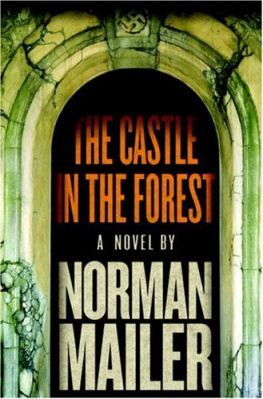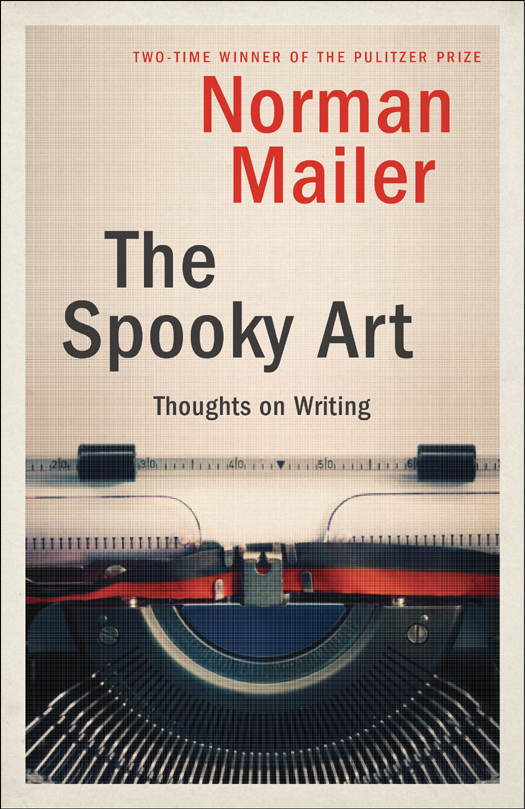Copyright 2003 by Norman Mailer
All rights reserved under International and Pan-American Copyright Conventions. Published in the United States by Random House, Inc., New York, and simultaneously in Canada by Random House of Canada Limited, Toronto.
R ANDOM H OUSE and colophon are registered trademarks of Random House, Inc.
Library of Congress Cataloging-in-Publication Data
Mailer, Norman.
The spooky art: some thoughts on writing / Norman Mailer.1st ed.
p. cm.
eISBN: 978-1-58836-286-5
1. Mailer, Norman. 2. FictionAuthorship. 3. Authorship. I. Title.
PS3525.A4152 S66 2003 808.02dc21 2002029170
Random House website address: www.atrandom.com
v3.1_r1
TO
J. MICHAEL LENNON
Praise for Norman Mailer
[Norman Mailer] loomed over American letters longer and larger than any writer of his generation.
The New York Times
A writer of the greatest and most reckless talent.
The New Yorker
Mailer is indispensable, an American treasure.
The Washington Post
A devastatingly alive and original creative mind.
Life
Mailer is fierce, courageous, and reckless and nearly everything he writes has sections of headlong brilliance.
The New York Review of Books
The largest mind and imagination at work [in modern] American literature Unlike just about every American writer since Henry James, Mailer has managed to grow and become richer in wisdom with each new book.
Chicago Tribune
Mailer is a master of his craft. His language carries you through the story like a leaf on a stream.
The Cincinnati Post
CONTENTS
He lived at a little distance from his body, regarding his own acts with doubtful side-glances. He had an odd autobiographical habit which led him to compose in his mind from time to time a short sentence about himself
James Joyce, A Painful Case
I was never so rapid in my virtue but my vice kept up with me. We are double-edged blades, and every time we whet our virtue the return stroke straps our vice.
Henry David Thoreau, Journals
A PREFACE WITH THREE WARNINGS AND ONE APOLOGY
During the seven years I worked on Harlots Ghost, I perceived the CIA and its agents as people of high morals and thorough deceit, loyalty and duplicity, passion and ice-cold detachment. So many writers, including myself, have a bit of that in our makeup. It is part of what has made us novelists, even as intelligence agents are drawn to their profession by the striking opposites in their natures.
Let me assert from the outset, however, that The Spooky Art is not a book about intelligence agents. A work of that sort I might call The Art of the Spooks. This book, however, as the subtitle states, is about writing, its perils, joys, vicissitudes, its loneliness, its celebrity if you are lucky and not so very lucky in just that way. Needless to add, it speaks of problems of craft and plot, character, style, third person, first person, the special psychology of the writer. (I do not think novelistsgood novelists, that isare altogether like other people.) We novelists, good and bad, are also closet philosophers, and one is ready thereforehow not?to offer ones own forays into the nature of such matters as being and nothingness, the near-to-unclassifiable presence of the unconscious and its demonic weaponwriters block. En route, one looks into the need for stamina in doing a novel, and the relation of stamina to ones style. There are discussions of the differences and similarities between fiction and history, fiction and journalism, and, of course, I have often thought about the life of action and the life of meditation as it affects ones work. I have talked and written about the pitfalls of early success and how to cope with disastrous reviews and how we each do our best to live with the competitive spirit of the novelist rather than be eaten out by it. There is talk about identity and occasional crises of identity, as well as the presence of the unconscious in relation to the novelist, taken together with such strategems as when it is wise to enter a characters mind and when it is unwise to make characters out of real people in ones life.
All of that is concerns Genre and Colleagues. Since writers are often in search of how to work in other arts and crafts, Genre has to do with film and painting and journalism, with television and graffiti, as examples of some of the ways and by-ways down which writers search and/or flee from their more direct responsibility.
Finally, there is another section at the end called Giants and Colleagues, filled with a mix of thoughtful and/or shoot-from-the-hip candor about some of my contemporaries, rivals, and literary idols, as well as a few pieces of more formal criticism. Among the authors discussed, some in reasonable depth, others in no more than passing comment, are Hemingway, Faulkner, Dostoyevsky, Tolstoy, Updike, Cheever, Roth, Doctorow, Capote, Vidal, Bellow, Heller, Borges, James Jones, Styron, Chekhov, James T. Farrell, Henry Adams, Henry James, Garca Mrquez, Melville, Proust, Beckett, Dreiser, Graham Greene, William Burroughs, Scott Fitzgerald, Nelson Algren, Kurt Vonnegut, Dwight Macdonald, Toni Morrison, Thomas Wolfe, Tom Wolfe, Jean Malaquais, Don DeLillo, Henry Miller, John Steinbeck, Christopher Isherwood, William Kennedy, Joan Didion, Kate Millett, Jonathan Franzen, Ralph Ellison, Joyce Carol Oates, John Dos Passos, D. H. Lawrence, Mark Twain, Freud, and Marx. Even Bill Buckley is mentioned (in relation to character versus plot). And Stephen King for style.
Taken all together, the resultone would hopeis a volume able to appeal to serious writers and to people who wish to write, to students, to critics, to men and women who love to read. But most of all, this may be a book for young novelists who wish to improve their skills and their commitment to the subtle difficulties and uncharted mysteries of serious novel-writing itself.
Now, for the warnings. A good deal of hesitation went along with the title. Spooky is virtually a childs word and seemed too casual. Besides, it does not always apply. Not all days at ones desk are odd or subtly frightening or, for that matter, full of scary fun. Novel-writing can be dogged. There are unproductive hours that feel like nothing so much as the act of trying to start an old car when the motor has gone dead on you.
Nor is this a geriatric analogy. It is usually young men who have old cars. Moreover, there is no sense of youth that a young man can feel on a truly bad day of writing. Young novelists do get to feel like old men on such unhappy occasions, as if whatever talent they once possessed is now gone. The first intimation of old age for many a young novelist is the day when the gift does not appear, or comes through hobbled. Scenes that one expected to be rich are without presence on the page. Ones inner lifethat exceptional sense of oneself as possessed of thoughts that are not like othersis absent. The scene one is working on is as boring as ones breath on a dull day.
That is the worst, and there is nothing mysterious about such mornings, afternoons, or nights unless it is the new and intimate sense that destiny never guarantees a happy end. You are brought up close, on such occasions, to the future rigor of an unhappy denouement for yourself.










